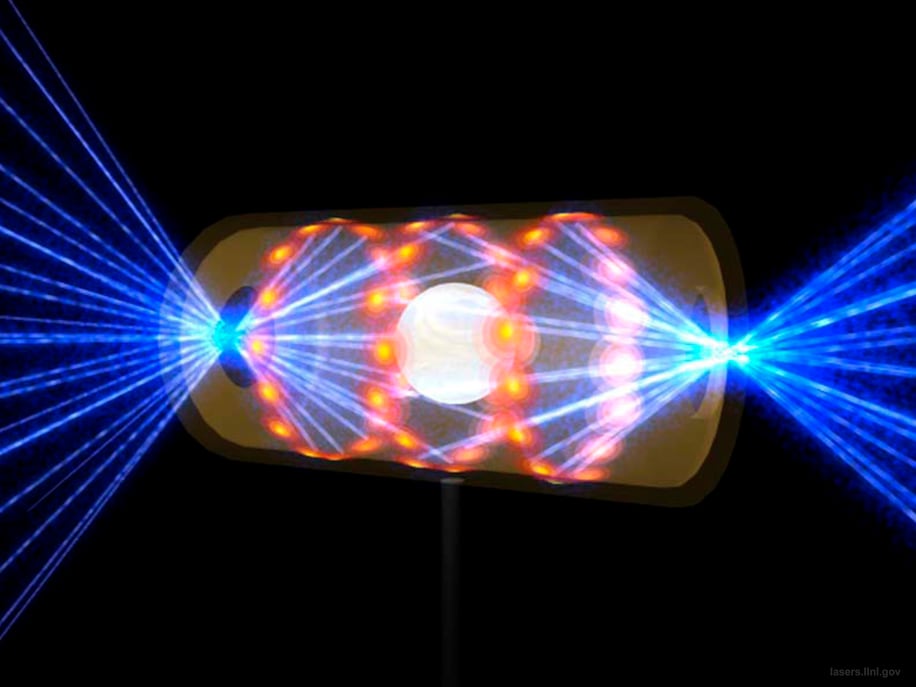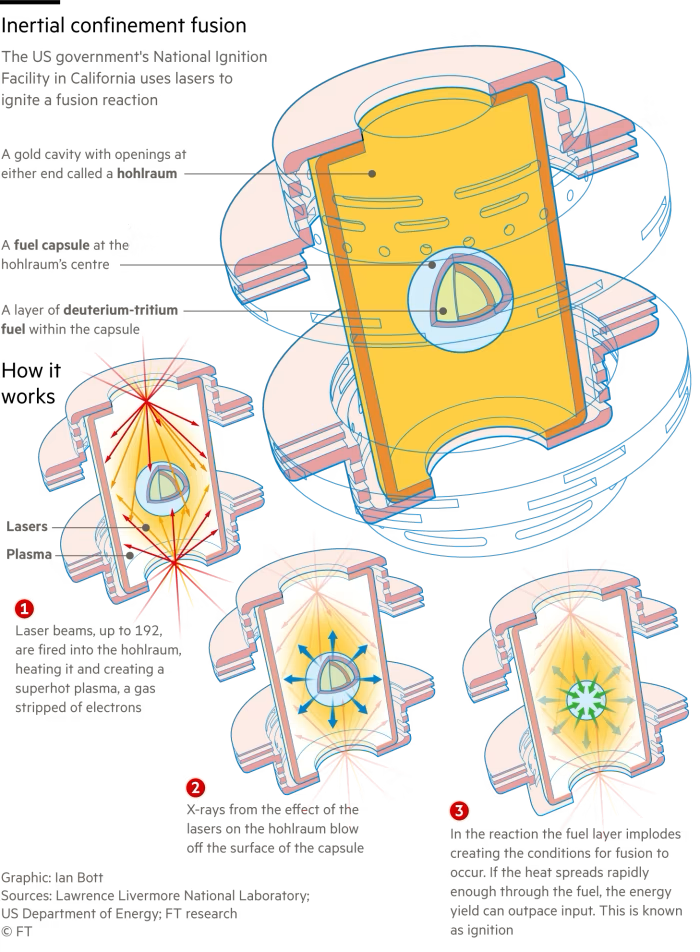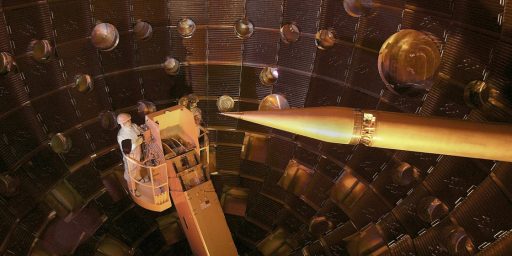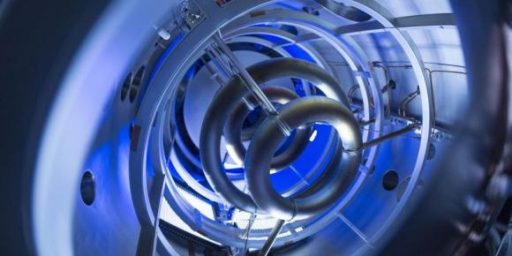Fusion Clean Energy ‘Breakthrough’ Made
The Energy Department is expected to make a big announcement tomorrow.

Financial Times (“Fusion energy breakthrough by US scientists boosts clean power hopes“):
US government scientists have made a breakthrough in the pursuit of limitless, zero-carbon power by achieving a net energy gain in a fusion reaction for the first time, according to three people with knowledge of preliminary results from a recent experiment.
Physicists have since the 1950s sought to harness the fusion reaction that powers the sun, but no group had been able to produce more energy from the reaction than it consumes — a milestone known as net energy gain or target gain, which would help prove the process could provide a reliable, abundant alternative to fossil fuels and conventional nuclear energy.
The federal Lawrence Livermore National Laboratory in California, which uses a process called inertial confinement fusion that involves bombarding a tiny pellet of hydrogen plasma with the world’s biggest laser, had achieved net energy gain in a fusion experiment in the past two weeks, the people said.
Although many scientists believe fusion power stations are still decades away, the technology’s potential is hard to ignore. Fusion reactions emit no carbon, produce no long-lived radioactive waste and a small cup of the hydrogen fuel could theoretically power a house for hundreds of years.
The US breakthrough comes as the world wrestles with high energy prices and the need to rapidly move away from burning fossil fuels to stop average global temperatures reaching dangerous levels. Through the Inflation Reduction Act, the Biden administration is ploughing almost $370bn into new subsidies for low-carbon energy in an effort to slash emissions and win a global race for next-generation clean tech.
The fusion reaction at the US government facility produced about 2.5 megajoules of energy, which was about 120 per cent of the 2.1 megajoules of energy in the lasers, the people with knowledge of the results said, adding that the data was still being analysed.
They provide this graphic:

The US department of energy has said energy secretary Jennifer Granholm and under-secretary for nuclear security Jill Hruby will announce “a major scientific breakthrough” at the Lawrence Livermore National Laboratory on Tuesday. The department declined to comment further.
The laboratory confirmed that a successful experiment had recently taken place at its National Ignition Facility but said analysis of the results was ongoing. “Initial diagnostic data suggests another successful experiment at the National Ignition Facility. However, the exact yield is still being determined and we can’t confirm that it is over the threshold at this time,” it said. “That analysis is in process, so publishing the information . . . before that process is complete would be inaccurate.”
Two of the people with knowledge of the results said the energy output had been greater than expected, which had damaged some diagnostic equipment, complicating the analysis. The breakthrough was already being widely discussed by scientists, the people added. “If this is confirmed, we are witnessing a moment of history,” said Dr Arthur Turrell, a plasma physicist whose book The Star Builders charts the effort to achieve fusion power. “Scientists have struggled to show that fusion can release more energy than is put in since the 1950s, and the researchers at Lawrence Livermore seem to have finally and absolutely smashed this decades-old goal.”
WaPo (“U.S. to announce fusion energy ‘breakthrough’“):
The Department of Energy plans to announce Tuesday that scientists have been able for the first time to produce a fusion reaction that creates a net energy gain — a major milestone in the decades-long, multibillion-dollar quest to develop a technology that provides unlimited, cheap, clean power.
The aim of fusion research is to replicate thenuclear reaction through which energy is created on the sun. It is a “holy grail” of carbon-free power that scientists have been chasing since the 1950s. It is still at least a decade — maybe decades — away from commercial use, but the latest development is likely to be touted by the Biden administration as an affirmation of a massive investment by the government over the years.
Huge amounts of public and private funds have been funneled into the fusion race worldwide, with the aim of ultimately manufacturing fusion machinery that could bring electricity to the grid with no carbon footprint, no radioactive waste and far fewer resources than it takes to harness solar and wind power. Beyond the climate benefits, promoters say it could help bring cheap electricity to impoverished parts of the world.
“To most of us, this was only a matter of time,” said a senior fusion scientist familiar with the work of the National Ignition Facility at the Lawrence Livermore National Laboratory in California, where the discovery was made.
The development was first reported by the Financial Times on Sunday. It was confirmed by two people familiarwith the research, who spoke on the condition of anonymity to avoid getting ahead of the official announcement. Energy Secretary Jennifer Granholm was slated to make the announcement Tuesdayat a media event billed as the unveiling of “a major scientific breakthrough.”
The department and the lab declined to comment. A lab official said researchers there are still finalizing their analysis and will not be releasing any official findings before Tuesday.
Hopefully, a lot more detail will be forthcoming Tuesday. Harnessing fusion has been a topic of conversation as long as I can remember. How close we are to actually being able to apply this “breakthrough” isn’t at all clear from these reports.






I assume there is a long, long road between net-energy gain and building power plants. It’s not clear yet, but if the ultimate energy source is simply heat it can use a lot of existing equipment to actually generate power.
For anyone interested, here’s a 15-20 minute video about a couple of commercial fusion efforts that use very different technologies and principles. It’s part of the “Undecided with Matt Ferrell” series, which I highly recommend. His format is to outline a new alternative energy technology or new commercialization of an existing one, basically presenting the upside, and then conclude by talking about what the challenges are. In the several years he’s been doing this he has learned about the decimation that takes place between lab and pilot, between pilot and commercialization, and between commercialization and adoption/profitability.
[ed. Forgot the link]
https://www.youtube.com/watch?v=yNP8by6V3RA&t=312s
Obtaining power from fission is a relatively simple thing. Making a fission bomb proved complicated, but it was really not that hard. Making a fusion bomb was more difficult, but relatively easy to do given a trigger powerful enough.
IN all of the above, the hard part lay in discovering the scientific principles involved, the properties of radioactive elements, etc. The engineering was the “easy” part.
The thing is, the trigger for a fusion (hydrogen) bomb is a small fission bomb. Whereas to get uranium or plutonium to fission in a reactor, the problem is refining the former to get a larger concentration of U235 (enriched uranium), or making enough of the latter in a uranium breeder reactor. past that, you just pile enough fissile material in the right shape amid control rods, add a neutron moderator (usually water), and remove the rods*.
Fusion requires harnessing and controlling the power in a bomb like the one that destroyed Hiroshima. So the engineering problem is a tad more difficult.
*This is highly oversimplified, and if you do it this way you’ll likely die from radiation poisoning. But the gist is correct.
Huge, if true.
Pardon my cynicism.
Had fusion power been discovered and commercialized 30 years ago we might not not be staring climate change in the face. Another 20 years to get it ready for use? 2042? Another couple of decades to really propagate around the world? 2062? A bit late. A good thing, but a bit late.
@Michael Reynolds:
Would that it were so simple.
Industrial processes, from food processing to steelmaking to ceramics and such, use copious amounts of natural gas to power ovens and furnaces. I wouldn’t be surprised if some steel plants make use of coal, even.
Given cheap enough electricity, many if not all of these processes could switch to electric heating elements to produce the high temperatures required. These can be, you know, hot enough to melt steel.
Which brings in another issue: will fusion power plants be cheap?
Yes, hydrogen is plentiful and easy to obtain. But deuterium is less so, and tritium* requires a breeder fission reactor to make (and it’s hellishly expensive, too). Beyond the cost of fuel, how much will fusion plants cost to build and operate? Remember the promise that nuclear (fission) power would make electricity too cheap to meter?
These hydrogen isotopes contain more neutrons but sill only one proton, ergo they should be easier to fuse than regular hydrogen, which is one lone proton. Protons repel each other because they have a positive electric charge, but can be made to stick (not easily, see the post above) through the strong nuclear interaction. Adding neutrons to the mix, which have no electric charge, eases some of the repulsion issues.
This reminds me of the old saw “Buy the rumor, sell on the news”. There have been “breakthroughs” in the form of incremental improvements made over the last 60 years. Will it ever be practical? We don’t really know.
@Kathy:
Makes containment an interesting problem, for the very same reason. And fusion produces a fair amount of free neutrons.
@Jon: For fusion power, neutrons are pretty much the whole point. That’s where most of the energy from the fusion reaction ends up. Slam high-velocity neutrons into the walls of the containment chamber, heating it up, pump a cooling fluid through the walls of the chamber to carry away enough heat to keep the walls from melting. Use the heat carried away to boil water and drive a steam turbine. Other than the source of the heat, Hero would understand the basic principles.
@Kathy:
Almost all steel plants (that aren’t based on recycling scrap using electric furnaces) use coking coal.
Because it does a 3-in-1:
– direct heat,
– reducing chemical reaction from carbon monoxide to remove oxygen and oxides
– carbon itself: because steel is an alloy of iron and carbon; you must have a carbon source
I will wait for tomorrows announcement before I comment.
@Michael Cain: True, but a side effect of that process involves degrading the shielding and making it pretty radioactive over time. In conclusion, neutrons are a land of contrasts.
@JohnSF:
Can you use electricity for the furnace and the coal only for making carbon steel?
@Kathy:
I’ll raise you: replace the coal with plastic, rubber, and bio garbage and use less energy at the same time:
Green Steel
@Stormy Dragon:
It’s a nice idea; but because it doesn’t have the heat/reducing chemistry/carbon source trifecta of coking coal, it’s not there yet.
SSAB are doing something similar at Lulea.
But most recent info I have is that is still way more expensive than coked steel.
Definitely worth pursuing but at the moment if the West switched to this, China (and India?) would scoop the pool in global steel markets.
If the “green steel” was mandated behind protection, then the end products might be rendered non-competitive.
On reflection, this is an interesting medium term prospect.
But I don’t really see that it is revolutionary.
Given the likely scale and cost of actual power plants, what does it get us that we haven’t already got with fission?
If a baseload in addition to renewables is required (which it certainly is in N Europe; perhaps less so in the US) fission can do that job.
And perhaps even fission may not be needed, if geothermal can get it done: Quaise Energy is working to create geothermal wells made from the deepest holes in the world.
@Kathy: Tritium can be produced in a light water fission reactor. Of course, the question is whether the fusion process as demonstrated at Lawrence Livermore is scalable.
@JohnSF: Baseload is a requirement for grid services at minimum. Grid stability and resonance issues are not trivial and intermittant RE can not resolve unless there is baseload or mass dispatchable storage. Storage is too expensive, so baseload is needed in foreseable future – plus of course one has to have dispatchable on demand for those moments where wind and solar are in lulls (as will happen, as happened with Europe this summer). Even with continent scale wheeling for resiliance one is going to need.
So non-carbon baseload is a fundamental.
All this goes along with a massive need for grid improvement as the FT arty a few days ago discussed re our end of world. But the same holds true everywhere essentially and worse for USA land.
In re the FT arty. My PE colleagues in this area in energy are massively abuzz. It is my sentiment as per the leaks that flowed that there is the real deal – of course while the US lab process may not end up being commercial, the demonstration of Gain in effect is indicating the confluence of materials science advances, computer capacity for managing flux and overall technology package has apparently now reached the point where it is no longer fusion as running joke. Internal rumours in this area have been saying this, I think it is real. Capital will flow to the engineering problem. (of course the magical cheap energy predictions are going to be wrong, much like solar as magical cheap based on superficial reflexion, at same time the economics potential should be enormous).
This is definitely a milestone, but it is (1) only an incremental improvement on past achievements, and (2) is nowhere near fusion as a sustainable power source. There is a lot of morale boost in getting more energy out of a process than you put into it… but what’s needed to make this an industrial power source is to routinely, at scale, for a long time, get more usable power from the energy release than was used to build the facility, make the fuel, fire the lasers, etc. Including waste heat, transmission losses, etc. The real milestone will be when the power generated from the fusion energy release is sufficient to build and run the next iteration.
LOL, today’s xkcd comic has the perfect parody of this.
@Lounsbury:
Yes, baseload is needed re. Europe
(The reason I’m more tentative re. US is because I’ve had Americans claim renewables + hydro storage + supergrid can get tit done in North Am, and I don’t know enough re. wind/insolation/terrain details to make it worth arguing)
But I’m unclear that this offers major advantages over fission, which is likely to be a lot cheaper, easier and quicker to engineer at scale.
Lots of people say “radioactive waste”, but I don’t think that’s a deal-breaker, when you compare overall likely costs.
Technology is funny. We understood the basic function of transistors since 1925 and we understood components like diodes since they were patented in 1901 (based on research that was discovered in 1874). The first working proof of concept was in 1947 and the first commercial product was produced in 1951. Of course improvements have been made all along the way.
While we won’t be getting anything useful in the next 4 years it seems possible that inside a couple of decades might get us to something useful. In the meantime there is still a lot of low hanging energy to be had with solar, wind, and other alternatives. So color me optimistic?
@JohnSF: The Americans claiming such are wrong. The overall state of the American grid is in fact shambolic, and inter-regional as well as general stability issues are really more severe than Europe (ceteris paribus).
I was a US Navy Nuclear Officer (Engineer) so I have a general understanding way above the general public (I’ve also been involved in the public grid) and whenever I see some grand renewable “Green” scheme I usually laugh, do a thermodynamics energy balance, and say but if we ever get fusion I might give you a different answer, but not yet. I remember when the Lawrence Number (breakeven, barely) was achieved about 2 decades ago so fusion is only ten years away. I remember the bankruptcies of a couple of Texas-chartered banks that bet big on fusion around 1990 (General Atomics).
In general for fusion the radioactivity is from the activation of the containment vessel, almost all of which have a very (very very) short half life (mostly neutrons making Iron (Fe) something else (like Cobalt), or the Steel alloy elements like Chromium) – metalurgy problem. Everything is lower atomic numbers and atomic mass (~under 60) so nothing like Uranium/Plutonium/Americium, etc. as far as being nasty. Pretty much bury/ignore an old system for 10 years and it is no more radioactive (hazard) than the natural Potassium (K) found in bananas.
I kept this simple, yes other issues. And I’m 25 years out of the field.
One interesting byproduct is He (Helium) – in short supply.